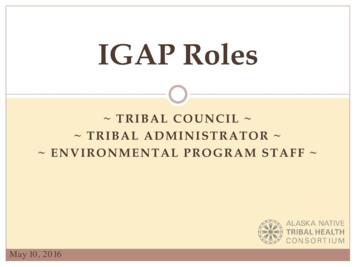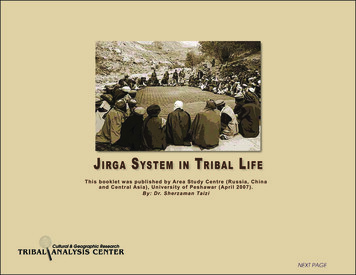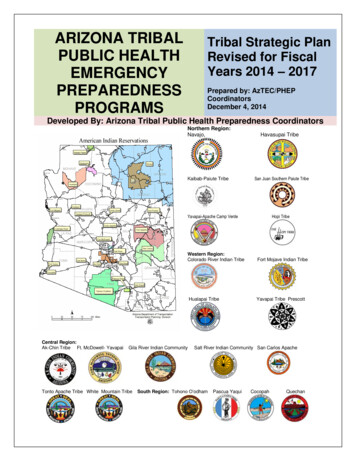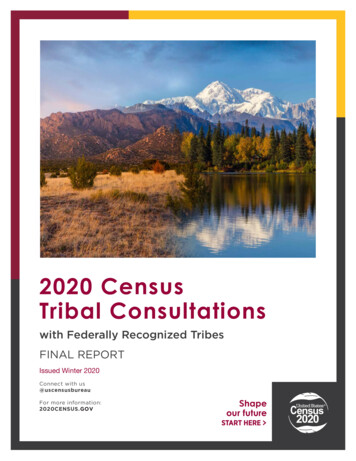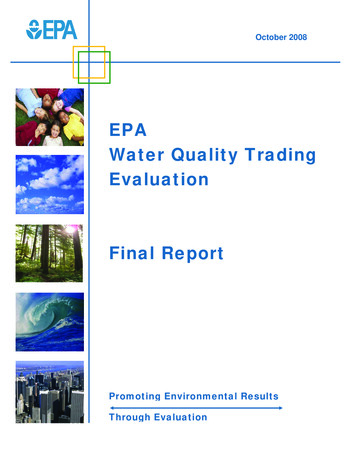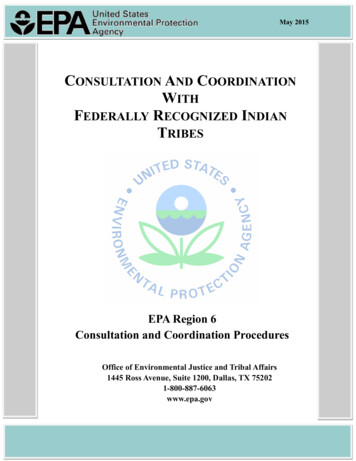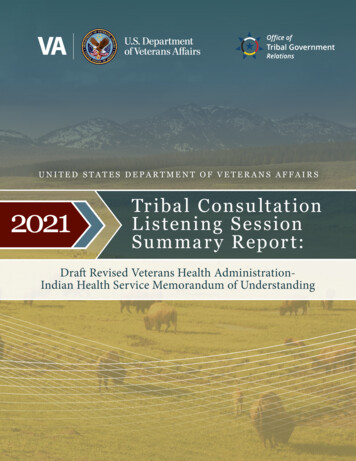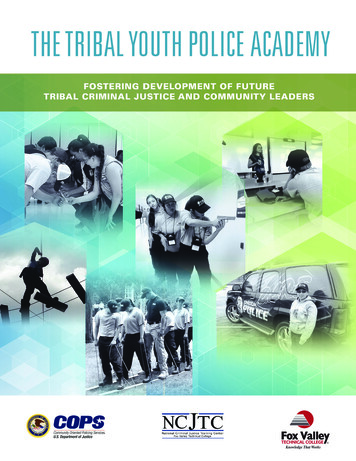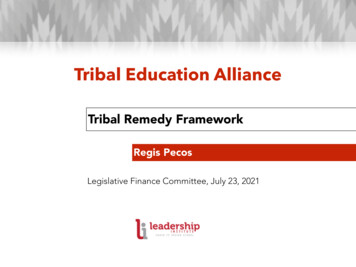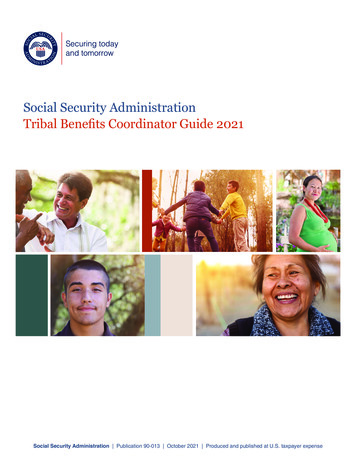
Transcription
EPA Region 10’sTribal Solid and Hazardous Waste ProgramAdvancing Lasting Improvements inTribal Waste ProgramsWA Department of Ecology,Waste2ResourcesMarch 2018 MeetingMarch 15, 2018Artist: Riley Ablowaluk, Teller, Age 5, Age 10,“Recycling Man”
Region 10 Tribal Waste TeamGabriela CarvalhoGrants, Contracts,Budget, BackhaulAlaska ProgramAngel IpTools, Training, Data,Technical Assistance,Research, HealthImpacts,CoordinationViccy SalazarOur Manager!Manager, Tribal Programs,Diesel, and Indoor AirUnit, Office of Air andWaste
Region 10 Tribal Waste TeamRick McMonagleTribal waste liaisonfor ID, OR, and WA,trainer, on-theground technicalassistanceTed JacobsonTribal waste liaisonfor AK, trainer, onthe-groundtechnical assistance
Today’s GoalsLearn about: What we do Tribal solid waste challenges and opportunities Coordination, collaborations, training, on-theground technical assistance, solid waste plan review& development Priority initiatives: Backhaul Alaska Rural Alaska Health Impacts InitiativeDiscuss: What are opportunities to collaborate with eachother and with Tribes in Region 10?
271 Federally Recognized Tribes in Region 10 Alaska, 228 Tribes: Mostly rural unlined landfills Tribes often work with localcities for joint services Mix of scenarios in Lower 3states, 43 Tribes: Tribe runs full program andlandfill/recycling facilities Tribe collects, disposal inoff-reservation facilities Collection/disposal servicesprovided by non-tribal utility
What We DoSupport Tribes as they work to develop improvedand sustainable waste management programsthrough: Strengthening the partner network Technical assistance Tools and training Grants, funding and contracts
Partner Networks Tribal Solid Waste Advisory Network (TSWAN) Solid Waste Alaska Taskforce (SWAT) Interagency Coordination Meeting on Waste Challengesin Rural Alaska Regional Tribal Operations Committee (RTOC) Northwest Interagency Partnership for SustainableCommunities Sustainable Materials Management Networks andWaste 2 Resources And more
FY 2017 GrantsKawerak (GAP) 100,000 to develop village training curriculum for the backhaulprogramBirch Creek Tribe (Hazardous Waste Grant) 68,374 to inventory HW sources, complete a community widehazardous waste assessment and develop a hazardous wastemanagement planTribal Solid Waste Advisory Network (Hazardous Waste Grant) 54,000 to deliver three training courses for tribal staff working in wastedisposal facilities on hazardous waste identification, proper storage andmanifesting of materials.
Support for AK, ID, OR, WA Tribes Coordination: Work with Tribes and agencies to mitigateillegal landfills, materials management, tire recycling, etc. Training: Match staff with requested assistance On-the-ground technical assistance: Tribal visits to assessneeds and status of solid waste programs
Support for AK, ID, OR, WA Tribes Information and Tools: Contacts, funding opportunities inpublic and private sector, reply to requests for information Solid waste plan review & development: Assist Tribes withIntegrated Solid Waste Management Plan reviews andrevisions Annual review of EPA Tribal Environmental Plans (ETEPs):Determine priority solid waste needs and issues
Common Requests from Tribes Site visits, assessments and technical assistance In-person training for environmental staff and Tribal leadership Grant writing assistance Assistance on developing waste inventories and integratedsolid waste management plans Resources / Tools / Information on a variety of solid andhazardous waste topics with specific requests for more: Funding Training Opportunities to work with professional networks
Tribal Solid Waste Advisory Network (TSWAN)2016 Top Tribal Waste Issues1. Illegal dumping on Tribal lands2. Insufficient communityeducation and outreach3. Current facilities andequipment not meeting needs4. Inadequate staffing and highturnover5. Need more fundingArtist: Rebekah Oguiluk, Teller, Age 12, Grade 7
Top Waste Training Needs for Tribes1. Asbestos2. Operations of hazardous wasteand transfer stations3. Develop/update integrated solidwaste management plans4. Water quality and soil sampling5. Operating Heavy Equipment in aLandfill (OHEL)6. Solid Waste Utility ManagementArtwork fromTununak’s Youth to Work ProgramYouth Ages 14-17 in Grades 7-12
Educational Tools for Assistance Providers andWaste Program Managers in Rural Alaska SWAT Guide to Solid Waste Management inAlaska Solid Waste Program Budgeting for AlaskaTribal Communities – A Beginner’s Guide Roadmap for funding sustainable solidwaste programs in rural Alaska Trail map step-by-step guide for improvingsolid waste management program Baseline report on waste backhaul costs Framework for operating a statewidebackhaul programArtist: Cathy Okbaok, Teller, Age 11, Grade 6
Indian Health Service and U.S. EnvironmentalProtection Agency, Memorandum of UnderstandingPurpose: Improve Open Dump Data, Solid Waste Projects and Programsin Indian CountryFocus Areas: Improve open dump inventory data in Operation and MaintenanceData System (OMDS) Collaborate on open dump assessment training for OMDS reporting Assessments and reporting on Tribal waste management programs Collaborate on the development and delivery of training Encourage Tribes to clean up and close open dumps
Priority Initiatives
Health Impacts of Waste in Rural Alaska InitiativeParticipants Tribal: Alaska Native Tribal HealthConsortium, Tanana Chiefs Conference,Yukon River Inter-Tribal WatershedCouncil Non-profit: Alaska Forum, RuralCommunity Assistance Corporation,Zender Group Research: Sustainable Earth Research Government: Agency for ToxicSubstances and Disease Registry, AlaskaDepartment of EnvironmentalConservation, Alaska Department ofHealth and Social Services, California AirResources Board, Indian Health Service,EPA Region 10Artist: Talisa Komok, Teller,Grade 2, Age 7“Keep our river clean”
Health Impacts of Waste in Rural Alaska InitiativeNeeds/Challenges
Health Impacts of Waste in Rural Alaska InitiativeHealth Issues Air quality Water and soil contamination Impacts on subsistence foods Children’s health and well-being Mental health Social determinants of health Zoonotic diseases Direct contact injury (dermal) Preventable diseases prevalence High cancer rates Risk perception Exposures to toxics and hazardouswaste
Health Impacts of Waste in Rural Alaska InitiativeActivities: Collating information and work completed to-date Identifying research needs and solutions Providing resources to implement research and solutionsInitial Focus Areas: Air quality Subsistence Foods Soil contamination Composting Water quality Anaerobic digestion Health messagingArtists: Youth in Huslia, AK
THANK YOU!Artist: TamaraAblowaluk, Teller,Grade 6, Age 11
EPA Region 10 Tribal Waste ContactsRick McMonagleTribal Waste Liaison (OR, ID, WA)McMonagle.Richard@epa.gov(503) 326-6363Ted JacobsonTribal Waste Liaison (AK)Tjacobson@ruralcap.com(907) 865-7363Angel IpTribal Waste CoordinatorIp.Angel@epa.gov, (206) 553-1673Viccy SalazarManager, Tribal Programs, Diesel, andIndoor Air Unit, Office of Air and WasteSalazar.Viccy@epa.gov(206) 553-1060Gabriela CarvalhoTribal Waste CoordinatorCarvalho.Gabriela@epa.gov(206) 553-6698
EPA Region 10 Tribal Waste Contacts Rick McMonagle Tribal Waste Liaison (OR, ID, WA) McMonagle.Richard@epa.gov (503) 326-6363 Angel Ip Tribal Waste Coordinator Ip.Angel@epa.gov, (206) 553-1673 Gabriela Carvalho Tribal Waste Coordinator Carvalho.Gabriela@epa.gov (206) 553-6698 Ted Jacobson Tribal Waste Liaison (AK) Tjacobson@ruralcap.com (907 .
